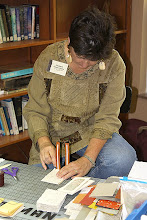If you follow the link above for Polstreath Beach, an interactive map will appear of the beach and Mevagissey through Geoeye Getmapping. If you move the map so that you can see the group of homes across the street, left of the beach, one of those homes belongs to Peter's sister and brother-in-law, Jo and Paul. What the map doesn't show you is the long, long staircase down ... and up ... to and from the beach - 96 steps from the cliff path if I recall....
Inspired by the colors and textures of flotsom, jetsom and beach pebbles collected from Cornwall, I just finished drying the fourth beater load of 12x16" flax and abaca paper pigmented in the colors of the coastal paths and brightly colored fishing boats.
Inner Harbour at Mevagissey with Fish Market in Distance
If you look closer at the interactive map from the Polstreath link above, you can easily see the Mevagissey inner harbor, fish market and outer quay.
Two batches have been dried and pressed, with the third in the press and the fourth on the line.
The final beater load will be pigmented with the deep ochres and russets of tumbled tiles and pavers washed ashore along with the black lava carried in the holds of commercial ships as ballast and dumped on the beach at Charlestown.
Charlestown Beach
















































